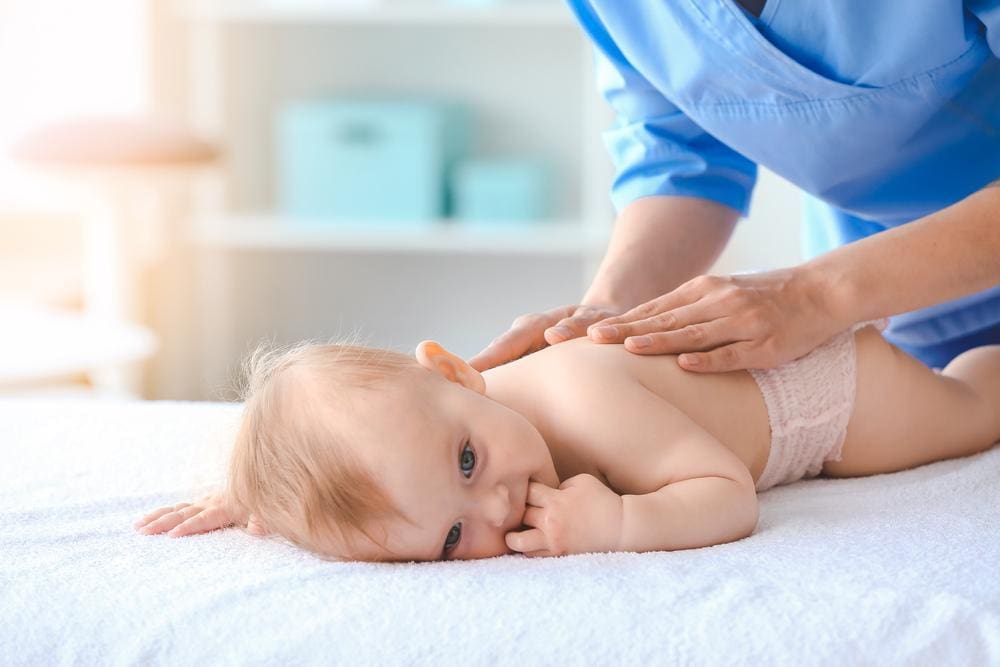
Flat head syndrome, also known as plagiocephaly, occurs when a section of a baby’s head is flattened. Although many cases of flat head or deformational plagiocephaly resolve on their own, some parents seek treatment to prevent complications. Chiropractic care is one of the best options for dealing with flat head syndrome.
The most common reason flat head syndrome occurs is because a baby spends too much time in one position – usually on their back.
The medical community began recommending that parents position babies on their backs for sleeping in the early 1990s. This was to reduce the risk of sudden infant death syndrome (SIDS). Although this is still recommended for sleeping, it can lead to head flattening or positional plagiocephaly.
In addition to sleeping position, babies can also develop flat head syndrome due to a restriction of movement in the uterus. This is why it tends to occur more for twins. Breech babies also have a higher risk of flat head syndrome.
Finally, babies can have flat head syndrome due to a birth defect. Congenital plagiocephaly occurs when the joints between the skull bones close too early. Surgery is usually needed to correct this severe case of flat head syndrome.
Usually, flat head syndrome is not a serious problem. In many cases, it resolves itself once the baby begins sitting up and moving on his or her own.
However, it’s a good idea to speak to your doctor about flat head syndrome as soon as you notice a problem. Baby’s skulls are softer at birth than they are as time passes. If assistance is needed with reshaping, such as helmet therapy, it’s best to begin treatment early before your baby’s skull hardens.
In many cases, the best way to deal with flat head syndrome is to prevent it before it develops.
How can you avoid flat spots from forming?
The less time your baby spends in one head position, the better. If you put your baby to sleep on their back, avoid having the back of their head resting flat at other times. To prevent your baby from spending too much time in one position:

Ensuring that your baby isn’t always in the same position is a great way to prevent or improve a misshapen head. Your baby is likely to move throughout the night, but laying your baby in a different position promotes healthy development.
Although you might be tempted to use pillows or sleeping devices to position your baby, most medical professionals recommend against this.
Changing feeding positions is one of the easiest and best ways to avoid or correct flat head syndrome. Some of the best feeding positions include:
All three of these positions work whether you are breastfeeding or feeding your baby with a bottle. You can adjust them as needed, as long as your baby isn’t resting his or her head in the same position.
Another way to reduce your baby’s risk of developing flat head syndrome is to increase his or her neck and head movement. Do this by:
You can also:
Tummy time is a great way for your baby to exercise. It strengthens their neck, shoulders, and arms. It prevents them from developing a stiff neck and gets your baby engaged in a different position than they spend most of their early weeks.
One of the best ways to reduce your baby’s risk of developing a flat spot on their head is to hold them. Don’t be afraid to hold your baby as often as you can. There’s no such thing as spoiling a newborn with too much snuggling and holding. It’s one of the best ways to engage your baby and bond.
Of course, you can’t spend every minute of the day carrying your baby in your arms. When you need to do other things that require your hands and arms, consider baby-wearing. Using a wrap to carry your baby hands-free minimizes the pressure on their head and encourages the development of strong neck muscles.
In addition to all of the things you can do throughout your day to reduce your baby’s risk for or correct flat head syndrome, you can also take your baby to a chiropractor.

There are several benefits to using chiropractic treatment for flat head syndrome. For instance, a chiropractic adjustment:
Spinal misalignment creates pressure and can damage the development of the cranial bones. An adjustment fixes the misalignment and allows the cranial bone to develop properly.
Torticollis causes asymmetrical positioning of the head due to weak or shortened neck muscles. Chiropractic care loosens neck muscles and alleviates torticollis. This ensures your baby can easily move his or her head in different directions.
Helping a baby’s spine to develop properly ensures they can turn their heads as much as possible. This reduces the risk that they’ll develop a flat head from always holding their head in one position.
Spinal misalignment can make feeding time a nightmare. Chiropractic care corrects misalignments so your child is more comfortable nursing.

Chiropractic care is a safe, non-invasive treatment that can help babies with flat head syndrome and other issues. Even if your child doesn’t have a problem with a flat head, they can still benefit from a visit to the chiropractor. If you’d like to reduce your baby’s risk of developing a flat spot, correct flat head syndrome, or promote the best possible development, consider scheduling a visit with a chiropractor.

© Accident Care Chiropractic | Hablamos Español
Located in: North Portland, NE Portland, SE Portland, Gresham, Clackamas, Oregon City, Hillsboro, Bethany, Beaverton, Tigard, Forest Grove, Woodburn,
McMinnville, Keizer, Salem, South Salem, Bend, Springfield, Vancouver, Hazel Dell, East Vancouver, Pasco, Kennewick, Lakewood.
We Specialize in Car Accident Treatment & Recovery
Home | About Us | Testimonials | Blog | Sitemap | Privacy Policy | Services | Locations | Contact Us